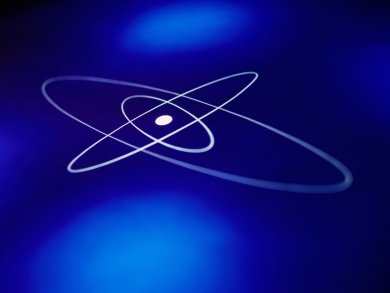Ernest Rutherford is known as the father of nuclear physics. Born on August 30th 1871 in New Zealand, he attended the University of New Zealand, Wellington, and graduated in 1893 with a double first in Mathematics and Physical Science. He moved to McGill University, Montreal, Canada, in 1898, where he worked on radioactive bodies, particularly on the emission of alpha rays. He differentiated and named alpha and beta radiation and discovered the concept of radioactive half-life. For this work, he was awarded the Nobel Prize in Chemistry in 1908.
Rutherford moved to the University of Manchester, UK, in 1907. His investigations into the scattering of alpha rays and the nature of the inner structure of the atom which caused such scattering led to the postulation of the “nucleus” as a concept. He was instrumental in defining elements by their atomic number. In 1919, Rutherford became Cavendish Professor of Physics at Cambridge University, UK.
Rutherford died in 1937 and was buried in Westminster Abbey, London, UK, next to other great scientists such as Newton and Kelvin. In 1997, element 104 was named rutherfordium in his honor.
Update (July 11, 2018)
We have changed the article to reflect historical research published in 2016. The article originally stated that Rutherford was the first to deliberately transmute one element into another—nitrogen into an oxygen isotope. However, it was Patrick Blackett, a research fellow working under Rutherford, who showed that a transmutation was taking place. We would like to thank Steven B. Krivit for bringing this to our attention.
Update (Jun 3, 2019)
The article originally stated that Rutherford worked at Cambridge University from 1907 on. We would like to thank Robin Marshall for bringing this to our attention.
See also
- 200th Birthday of Robert Wilhelm Bunsen
Robert Wilhelm Bunsen did groundbreaking work in organic chemistry and spectrometry, but he’s most famous for the Bunsen burner - 100th Birthday of Feodor Lynen
Feodor Lynen, Noble Prize winner and biochemist from Munich, was born April 6, 1911





Rutherford was not the first to deliberately transmute one element into another—nitrogen into an oxygen isotope. It was performed, analyzed and published (only) by Patrick Blackett, a research fellow working under Rutherford. More information on this intriguing misappropriate of scientific credit: http://history.aip.org/history/exhibits/rutherford/sections/atop-physics-wave.html
Steven B. Krivit
I’m afraid you’ve got yourself into a bit of a mess here. Ernest Rutherford moved from Montreal to Manchester in 1907 and not Cambridge. By your mistake, you have assigned all his profound discoveries to the wrong university and insulted another.
Secondly, it not possible to rewrite history a hundred years later on a whim. It was accepted by the whole community of physicists at the time that Rutherford observed transmutation of nitrogen in 1919 in Manchester. The initial state in his reaction was a helium nucleus and a nitrogen nucleus. In the final state he observed a proton and a recoil nucleus that he described with surprise that should have been nitrogen but looked like oxygen. If that is not transmutation, I don’t know what is.
Rutherford was loth to use word transmutation (see Soddy’s autobiog) since “they” would have his head as an alchemist. He used the word “disintegration” as did Blackett in his confirmatory publication 5 years later. But he most telling thing is that Blackett, in his Rutherford memorial lecture in 1954, says of the process “discovered by Rutherford”.
I won’t tell you what do, you are chemists and I am a physicist, but this article of yours is a serious embarrassment. The centenary of transmutation will be celebrated in Manchester on the 8th of June, with prude, joy and honesty.
Dear Professor Marshall,
thank you very much for your comment. We would like to apologize for the error in Rutherford’s affiliation and have corrected the mistake.
Where the credit for the first man-made nuclear transmutation is concerned, things seem to bit a little less clear. We were alerted to this by Steven B. Krivit some time ago. His conclusions were supported by the U.S. Department of Energy and the American Institute of Physics. Please see the following links:
https://www.osti.gov/opennet/manhattan-project-history/Events/1890s-1939/exploring.htm
https://history.aip.org/history/exhibits/rutherford/sections/atop-physics-wave.html
However, we encourage discussion on the subject.